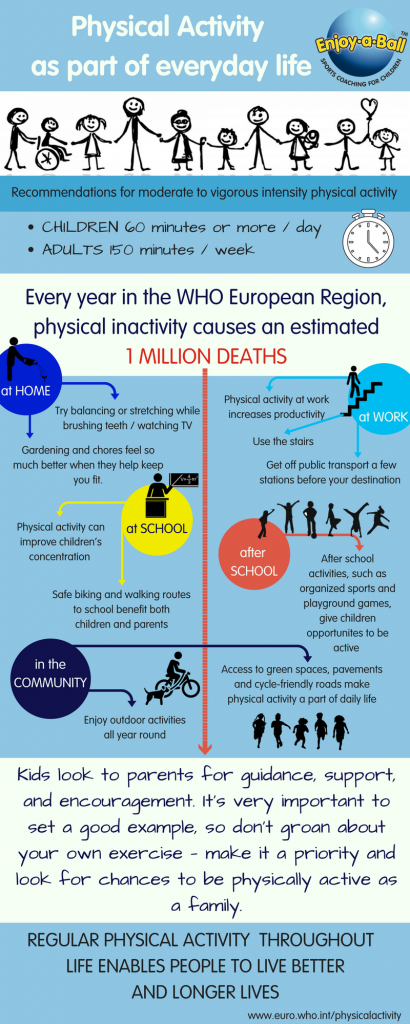
You may have read lots of headlines recently about the importance of doing physical activity and the impacts of sedentary activity. For young children, doing physical activity is really important for development and health & well-being.
In terms of development, interacting with physical and social environments is the way that children learn, and physical activity, both indoors and outdoors, provides many opportunities for these interactions. You may sometimes wonder why your child’s Enjoy-a-Ball coach uses such a lot of different types of equipment within one class, for example beanbags, tennis ball, big ball, flying disc. Interacting with each of these brings different sensory experiences, through which learning occurs. In addition, seeing the coach doing the activity motivates the child to participate, along with the praise that the coach also provides.
The movement involved in physical activity has benefits for their hearts, bones, muscles and mental health, and may also benefit cognition. In contrast, sitting has negative impacts for health and reduces the interactions with different environments.
Additionally, if children develop physical literacy and become confident at doing physical activity, this will support them in belonging to social groupings and reaching their occupational potential.
Recent ‘physical activity report cards’ in 38 countries (Tremblay et al., 2016) have highlighted that there is a gap between the provision of policy and infrastructure to encourage children to do physical activity, and the actual participation of children in physical activity. In general, countries with advanced economies have a much bigger gap, whereas children in less developed countries tend to do much more physical activity. Lifestyle changes which have led to increases in sedentary activity, and over which children have no control, are one of the reasons for these gaps. Reductions in active transport to nursery and school, increased time in childcare, time pressures for parents, fewer siblings and safety concerns all contribute to this. In contrast, there is evidence that if a young child develops the habit of doing physical activity, this will track through into later life as well as laying the foundations for a healthy life. In order to do this, it is important to encourage them to recognise physical activity as part of their occupational identity, that they are a physically active being. However, if adults with whom children spend time do not recognise physical activity as part of their own occupational identity, they may have less motivation to spend time with children doing physical activity.
Consequently, we all need to think about our own physical activity – next time we think we’ll just jump in the car to go to the shop, why not walk there with the children instead, and have a chat about how good doing physical activity makes us feel, and how important it is to build it into our day! Have ‘Summer of Fun’ kit ready in the car – a ball, a frisbee and trainers, ready to take advantage of any opportunity to do physical activity wherever you happen to be!
Enjoy!
Daily tips to help keep your family active.
Reference:
Tremblay M. S., Barnes J. D., González S. A., Katzmarzyk P. T., Onywera V. O., Reilly J. J., Tomkinson G. R., and the Global Matrix 2.0 Research Team (2016) “Global Matrix 2.0: Report Card Grades on the Physical Activity of Children and Youth Comparing 38 Countries” in Journal of Physical Activity and Health Vol. 13, S. 2, pp. 343-366
No comments yet